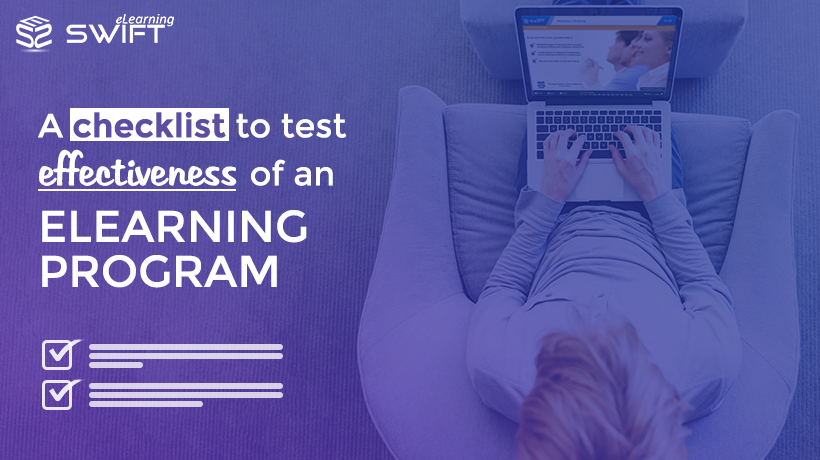
It is a challenge for training managers to ensure quality of eLearning programs that are developed by internal teams or external eLearning vendors.
In this blog, we will equip training / Learning and Development managers with a benchmark checklist that helps them test effectiveness of an eLearning program.
Here is a checklist…
Logical organization of the content (concept) flow
Randomly compare two consecutive concepts and check whether the first concept is serving as an advance-organizer to the second concept. Similarly, continue this process till the end of the course. At micro level; put a check within each concept by comparing sentences.
Content relevancy to the immediate need
To check the relevancy of the concept with the immediate need that it fulfils; put a check on following two areas:
List of learning objectives – It is very important that each objective should be relevant to the learning need.
The content covered for each objective – The content should corresponds to any one or more objectives listed in the beginning of the course. Every line of text should help learner to achieve the defined knowledge or skill – the content scope should be very focused to meet its objective.
Content writing style and the size
Writing content to help someone acquire knowledge and skill is different than helping someone to accept a viewpoint. The instructional content should be self-explanatory, easy to comprehend and retain for longer time.
Check for the following:
- Concept building approach – it must flow from,
-
- Known to unknown
- Simple to complex
- Presence of jargon or complex sentence formations – content must be drafted in plain English
- One concept should be expressed in one sentence or one paragraph or one topic. Do not mix two concepts in one unit of content
Instructional graphics style and convey-ability
If we believe that ‘a picture is worth 1000 words’, then it is quite important to ensure they look beautiful and convey the intended meaning.
Check following essential features of a graphic:
- The color – minimal color usage limited to branding guidelines
- The arrangement of sub-elements in collage of graphics; and off-course shapes and strokes
- The overall graphic layout meaning –infographics such as circular layout for life-cycles, star layout for components etc.
Learner Engagements
There are variety of strategies using which an instructional designer engage his/her learners. Here is the list of essential engaging techniques – an effective eLearning course should feature each or most of these techniques.
- Scenarios – create virtual contexts similar to the real-life workplace conditions
- Gamification – a simulated scenario that engages learner deep into the content
- Explainer videos – demonstrate desired skills that help learner imitate at workplace
- Intuitive Learner Interactions – to keep learner attentive throughout the course
- Emotions – to an extent, effective use of avatar can replace the benefit of real human element
- Formative Assessments – practice opportunities along with appropriate guidance
- Avoid distractions – avoid less necessary graphic animations, sounds and interactions
Responsive Design for multi-screen course delivery
Launch the course in common screen dimensions such as Desktop, Tablet and Smartphone. Check even in rotational screen modes. The course should scale to fit in different screen sizes smoothly.
Tracking
The course must be compliant in any of the online course delivery protocol such as SCORM or Tin Can. This helps training managers to implement course globally and with descriptive user analytics.
Conclusion
The blog covers the essential features and there are other features specific to the given unique learning need. Being one of the best eLearning companies in India; we delivery variety of eLearning courses that best suits to your unique eLearning requirement.
Source link: http://www.swiftelearningservices.com/how-to-measure-effectiveness-of-an-elearning-program-here-is-a-checklist/
I’m a believer in learning objectives. Recently, read content where they may not be as important in today’s training delivery as in the past. I’ve changed to keep the objectives to one or two. Do you have a best practice currently used regarding the number of learning objectives – knowing each training will be different?
You must be logged in to post a comment.









